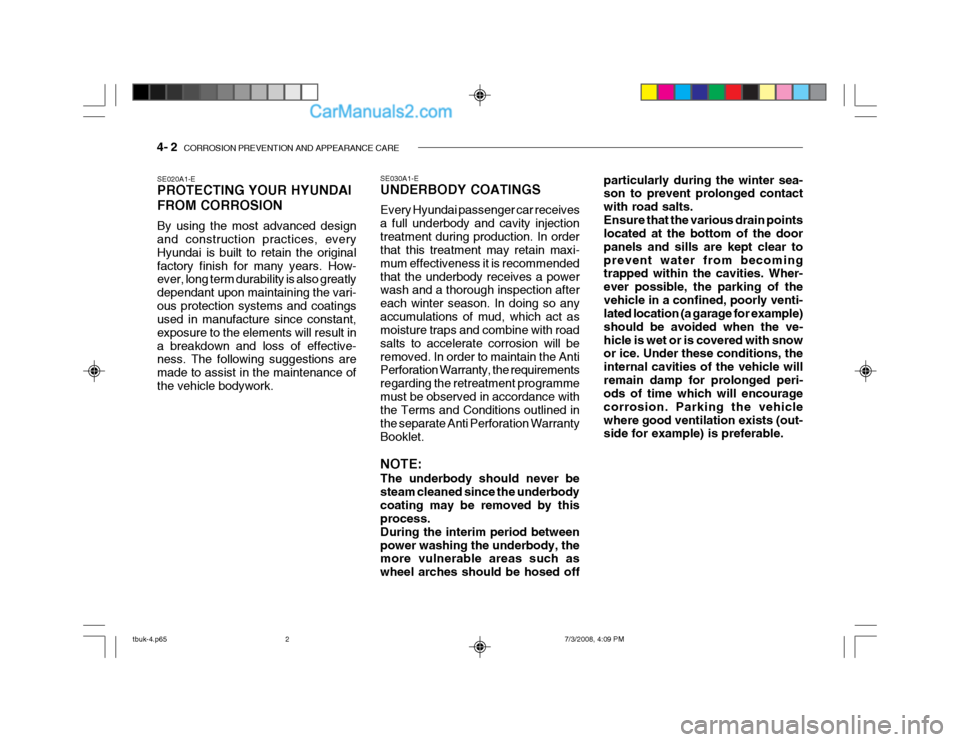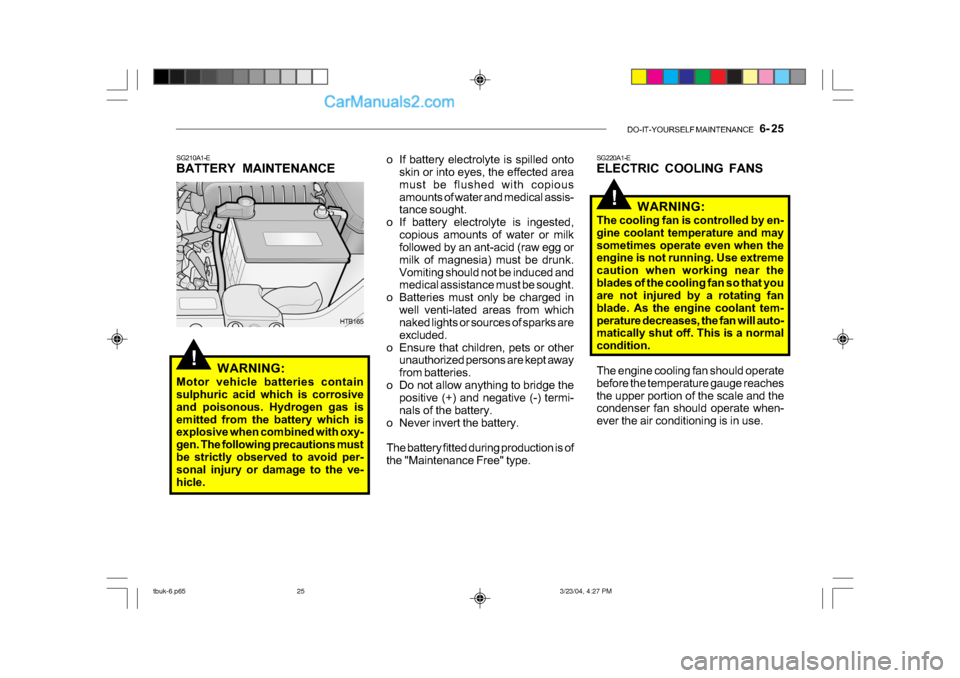Page 365 of 445

3- 2 WHAT TO DO IN AN EMERGENCY
HTB165
SD020B1-E
IF THE ENGINE CANNOT BE
CRANKED
1. If the vehicle is fitted with manual
transaxle, ensure that the clutch
pedal is depressed whilst cranking
the engine. If the vehicle is fitted
with automatic transaxle, ensure
that the transaxle selector is at the
"P" or"N" position.
2. Check the battery terminals and
connections to ensure that these
are clean and also tight.
3. If the ignition warning lights dim
when the engine is cranked and the
battery terminals have been
checked, a discharged battery is
indicated. SD020C1-F
If Engine Turns Over Normally
but Does Not Start
SD020A1-E
IF THE ENGINE WILL NOT START
Seek assistance from the nearest
Hyundai dealer with regard to the
method of ignition and fuel system
diagnosis.
!
HTB221
CAUTION:
If the engine refuses to start, no
attempt should be made to push or
tow start the vehicle. Vehicles with
automatic transaxle or fuel injec-
tion will not be able to be started in
this manner since no drive is trans-
mitted through the automatic
transaxle whilst the engine is not
running, and in the case of fuel
injected derivatives, the fuel pump
will not operate under tow start
conditions. In addition, if the ve-
hicle is equipped with an exhaust
catalyst, damage to the catalyst may
result if the vehicle is tow started. 4. Do not attempt to push or tow start
the vehicle, refer to "Jump Starting"
for information regarding engine
starting when the battery is dis-
charged.
1. Check fuel Level
2. Check all connectors at ignition coil and spark plugs.
Replace any that may be discon-
nected or loose.
3. Check fuel line in the engine com- partment.
4. If engine still refuses to start, call a
Hyundai dealer or seek other quali-
fied assistance.
tbuk-3.p65 3/23/04, 4:24 PM
2
Page 369 of 445

3- 6 WHAT TO DO IN AN EMERGENCY
SD060A1-E
IN THE EVENT OF A PUNCTURE
If a puncture occurs whilst driving the
vehicle:
1. Bring the car to rest as soon as it is
safe to do so and with the minimum
amount of braking required which
will assist in maintaining the maxi-
mum amount of control. The vehicle
should be parked wherever pos-
sible upon firm level ground to facili-
tate wheel changing.
2. If the vehicle is creating a hazard and the road conditions do not per-
mit the wheel to be changed safely,
assistance should be sought.
3. Passengers must not be allowed to
remain inside the vehicle during
wheel changing. If a puncture oc-
curs whilst the vehicle is on a
motorway, the passengers should
take refuge on the motorway em-
bankment to avoid the possibility of
injury occurring should the vehicle
be struck by other motorway traffic.
4. Wheel changing should be per-
formed according to the following
instructions.
SD050A2-E
SPARE WHEEL (Not all models)
The spare wheel is stored under the
luggage compartment floor and is ac-
cessed from within the luggage com-
partment by lifting the carpet and the
floor panel.
To remove the spare wheel, unscrew
the retainer, rotating this in an anti
clockwise direction and lift out the
wheel. To replace the wheel, screw
the retainer by hand until tight having
located the wheel in the luggage com-
partment floor well. The inflation pres-
sure of the spare wheel should be
checked at least monthly and when-
ever the wheel is fitted to the vehicle.
Inflation Pressure
Tyre Size
Spare Tyre Pressure
Full Size
210 kPa (30 psi)
CAUTION:
o Do not use snow chains with your temporary spare tyre.
o Do not use more than one tempo- rary spare tyre at a time.
!
5. The temporary spare tyre should
not be used on any other wheels,
nor should standard tyre, snow tyre,
wheel covers or trim rings be used
with the temporary spare wheel. If
such use is attempted, damage to
these items or other car compo-
nents may occur.
6. The temporary spare tyre pressure should be checked once a month
while the tyre is stored.
tbuk-3.p65 3/23/04, 4:24 PM
6
Page 378 of 445

4- 2 CORROSION PREVENTION AND APPEARANCE CARE
SE020A1-E PROTECTING YOUR HYUNDAI FROM CORROSION By using the most advanced design and construction practices, every Hyundai is built to retain the originalfactory finish for many years. How- ever, long term durability is also greatly dependant upon maintaining the vari-ous protection systems and coatings used in manufacture since constant, exposure to the elements will result ina breakdown and loss of effective- ness. The following suggestions are made to assist in the maintenance ofthe vehicle bodywork. SE030A1-E UNDERBODY COATINGS Every Hyundai passenger car receives a full underbody and cavity injectiontreatment during production. In order that this treatment may retain maxi- mum effectiveness it is recommendedthat the underbody receives a power wash and a thorough inspection after each winter season. In doing so anyaccumulations of mud, which act as moisture traps and combine with road salts to accelerate corrosion will beremoved. In order to maintain the Anti Perforation Warranty, the requirements regarding the retreatment programmemust be observed in accordance with the Terms and Conditions outlined in the separate Anti Perforation WarrantyBooklet. NOTE: The underbody should never be steam cleaned since the underbodycoating may be removed by this process. During the interim period betweenpower washing the underbody, the more vulnerable areas such as wheel arches should be hosed off particularly during the winter sea- son to prevent prolonged contact with road salts.Ensure that the various drain points located at the bottom of the door panels and sills are kept clear toprevent water from becoming trapped within the cavities. Wher- ever possible, the parking of thevehicle in a confined, poorly venti- lated location (a garage for example) should be avoided when the ve-hicle is wet or is covered with snow or ice. Under these conditions, the internal cavities of the vehicle willremain damp for prolonged peri- ods of time which will encourage corrosion. Parking the vehiclewhere good ventilation exists (out- side for example) is preferable.
tbuk-4.p65
7/3/2008, 4:09 PM
2
Page 416 of 445

DO-IT-YOURSELF MAINTENANCE 6- 25
!
!
o If battery electrolyte is spilled onto
skin or into eyes, the effected area
must be flushed with copious
amounts of water and medical assis-
tance sought.
o If battery electrolyte is ingested, copious amounts of water or milk
followed by an ant-acid (raw egg or
milk of magnesia) must be drunk.
Vomiting should not be induced and
medical assistance must be sought.
o Batteries must only be charged in well venti-lated areas from which
naked lights or sources of sparks are
excluded.
o Ensure that children, pets or other unauthorized persons are kept away
from batteries.
o Do not allow anything to bridge the positive (+) and negative (-) termi-
nals of the battery.
o Never invert the battery.
The battery fitted during production is of
the "Maintenance Free" type.
SG210A1-E
BATTERY MAINTENANCE
WARNING:
Motor vehicle batteries contain
sulphuric acid which is corrosive
and poisonous. Hydrogen gas is
emitted from the battery which is
explosive when combined with oxy-
gen. The following precautions must
be strictly observed to avoid per-
sonal injury or damage to the ve-
hicle.
HTB165 SG220A1-E
ELECTRIC COOLING FANS
WARNING:
The cooling fan is controlled by en-
gine coolant temperature and may
sometimes operate even when the
engine is not running. Use extreme
caution when working near the
blades of the cooling fan so that you
are not injured by a rotating fan
blade. As the engine coolant tem-
perature decreases, the fan will auto-
matically shut off. This is a normal
condition.
The engine cooling fan should operate
before the temperature gauge reaches
the upper portion of the scale and the
condenser fan should operate when-
ever the air conditioning is in use.
tbuk-6.p65 3/23/04, 4:27 PM
25